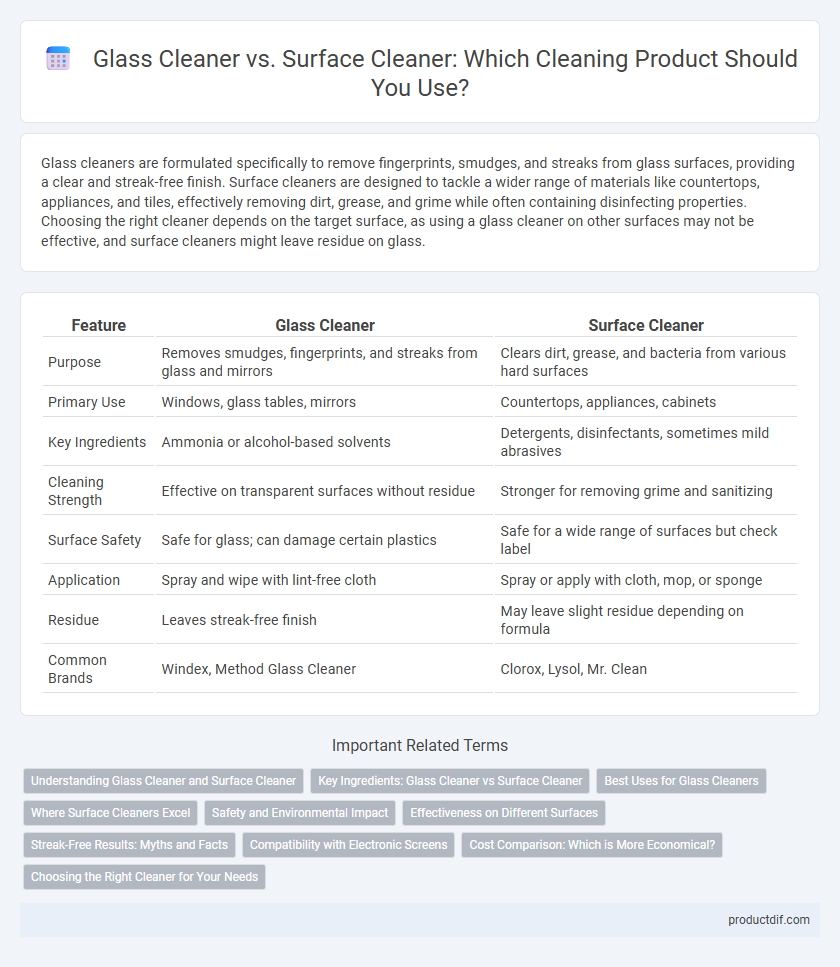Glass cleaners are formulated specifically to remove fingerprints, smudges, and streaks from glass surfaces, providing a clear and streak-free finish. Surface cleaners are designed to tackle a wider range of materials like countertops, appliances, and tiles, effectively removing dirt, grease, and grime while often containing disinfecting properties. Choosing the right cleaner depends on the target surface, as using a glass cleaner on other surfaces may not be effective, and surface cleaners might leave residue on glass.
Table of Comparison
| Feature | Glass Cleaner | Surface Cleaner |
|---|---|---|
| Purpose | Removes smudges, fingerprints, and streaks from glass and mirrors | Clears dirt, grease, and bacteria from various hard surfaces |
| Primary Use | Windows, glass tables, mirrors | Countertops, appliances, cabinets |
| Key Ingredients | Ammonia or alcohol-based solvents | Detergents, disinfectants, sometimes mild abrasives |
| Cleaning Strength | Effective on transparent surfaces without residue | Stronger for removing grime and sanitizing |
| Surface Safety | Safe for glass; can damage certain plastics | Safe for a wide range of surfaces but check label |
| Application | Spray and wipe with lint-free cloth | Spray or apply with cloth, mop, or sponge |
| Residue | Leaves streak-free finish | May leave slight residue depending on formula |
| Common Brands | Windex, Method Glass Cleaner | Clorox, Lysol, Mr. Clean |
Understanding Glass Cleaner and Surface Cleaner
Glass cleaner is specifically formulated to remove smudges, fingerprints, and streaks from glass surfaces using ingredients like ammonia or alcohol for a clear, streak-free shine. Surface cleaner is designed to tackle a broader range of materials such as countertops, tiles, and appliances, often containing detergents and disinfectants to remove dirt, grease, and bacteria. Choosing the right cleaner depends on the surface type, with glass cleaner optimized for transparency and surface cleaner focused on general grime and sanitation.
Key Ingredients: Glass Cleaner vs Surface Cleaner
Glass cleaners typically contain ammonia or isopropyl alcohol, which effectively dissolve grease and leave a streak-free shine on glass surfaces. Surface cleaners often incorporate surfactants such as sodium lauryl sulfate and disinfectants like quaternary ammonium compounds to remove dirt and kill bacteria on multiple surface types. The key difference lies in glass cleaners prioritizing clarity and residue-free finish, while surface cleaners focus on broader antimicrobial action and versatility.
Best Uses for Glass Cleaners
Glass cleaners are specifically formulated to remove fingerprints, smudges, and streaks from windows, mirrors, and glass surfaces, providing a crystal-clear shine without leaving residue. They typically contain ingredients such as ammonia or alcohol that evaporate quickly, ensuring streak-free results essential for transparency and clarity. Unlike surface cleaners designed for general dirt and grime on various materials, glass cleaners excel in enhancing visibility and shine on delicate glass surfaces.
Where Surface Cleaners Excel
Surface cleaners excel in versatility, effectively removing dirt, grease, and grime from a wide range of materials such as countertops, appliances, and sealed surfaces. Unlike glass cleaners that focus specifically on streak-free shine for windows and mirrors, surface cleaners often contain multi-purpose agents that tackle tougher residues and disinfect surfaces. Their formulation is ideal for maintaining hygiene and cleanliness in kitchens, bathrooms, and other high-touch areas where varied surface types coexist.
Safety and Environmental Impact
Glass cleaners typically contain ammonia-based formulas that effectively remove streaks but can emit strong fumes potentially harmful to respiratory health and indoor air quality. Surface cleaners often utilize biodegradable ingredients and non-toxic chemicals, reducing environmental impact and improving safety for household use, especially around children and pets. Choosing eco-friendly surface cleaners minimizes ecological footprints by avoiding harsh solvents and supporting sustainable waste management.
Effectiveness on Different Surfaces
Glass cleaners are specifically formulated with ingredients that remove streaks, fingerprints, and smudges from smooth, transparent surfaces like windows and mirrors, ensuring crystal-clear visibility. Surface cleaners contain a broader range of agents designed to tackle dirt, grease, and grime on various materials such as wood, plastic, and countertops, providing versatile cleaning power but may leave residues or streaks on glass. Choosing the appropriate cleaner maximizes effectiveness: glass cleaners excel at leaving glass spotless without hazing, while surface cleaners protect and maintain the finish of mixed-material surfaces.
Streak-Free Results: Myths and Facts
Glass cleaner formulations are specifically designed with ingredients like ammonia or alcohol to evaporate quickly, reducing streaks on transparent surfaces. Surface cleaners, often containing milder detergents and less volatile solvents, may leave residues that cause streaking, especially on glass. Achieving truly streak-free results depends more on the product's formulation and application technique than the category of cleaner used.
Compatibility with Electronic Screens
Glass cleaners often contain ammonia or alcohol, which can damage electronic screen coatings or cause discoloration. Surface cleaners designed specifically for electronic devices use gentle, non-abrasive formulas that safely remove fingerprints and smudges without harming screen sensitivity or clarity. Using a dedicated surface cleaner ensures compatibility with LCD, LED, and OLED screens, preserving their functionality and lifespan.
Cost Comparison: Which is More Economical?
Glass cleaner typically costs less per ounce than surface cleaner due to its specialized formula targeting transparent surfaces like windows and mirrors. Surface cleaners, designed for multi-purpose use on countertops, appliances, and other materials, often have higher ingredient complexity and packaging costs, leading to a higher price point. Evaluating cost-effectiveness depends on usage frequency and cleaning scope, where glass cleaners are more economical for glass surfaces and surface cleaners justify their expense for broader applications.
Choosing the Right Cleaner for Your Needs
Glass cleaner is specifically formulated to remove smudges, fingerprints, and streaks from glass surfaces, using ingredients like ammonia or alcohol for a crystal-clear finish. Surface cleaner is designed for a broader range of materials, including countertops, tiles, and stainless steel, with gentler ingredients that avoid damage or residue. Selecting the right cleaner depends on the surface type and desired outcome, ensuring effective cleaning without compromising material integrity.
Glass Cleaner vs Surface Cleaner Infographic

 productdif.com
productdif.com